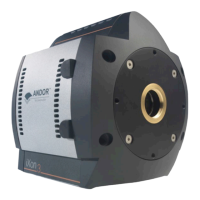Page 28
Features & Functionality
3.3.1 - Sensor PreAmp options
AnEMCCDsensorcanhaveamuchlargerdynamicrangethancanbefaithfullyreproducedwiththeAnalogue/Digital
converters and signal processing circuitry currently available on the market today. To overcome this shortcoming and
access the range of signals from the smallest to the largest and to optimize the camera performance it is necessary
to allow different pre-amplier gain settings. However, it is only ever recommended selecting something other than
the default highest PreAmp (most sensitive) setting for applications that are extremely challenged by dynamic range
concerns. It is very important, however, that for such high-dynamic range applications, the user applies even more care
to the amount of EM gain applied (high EM gain can drastically reduce the true dynamic range of the camera). Ideally, for
maximum dynamic range whilst maintaining improved Signal to Noise (S/N), the EM gain setting should be set equal to
the read noise at the readout speed selected (value obtainable from the performance sheet that comes with the delivered
system).
Pre-ampliergainselectioninCCDsistraditionallyusedtotradeoffS/Nvsdynamicrange.AhigherPreAmpsetting
meansfewerelectrons/count,resultinginalowersystemnoiseoor,thereforeahigherS/N.However,highPreAmp
settings may not match well to the pixel well depth of the sensor, therefore a lower setting can be selected to meet the
fullwelldepthpotential,e.g.aPreAmpsettingyielding1.5e-/countmaybeselectedtoensurethatthe65536digitization
levelsofa16-bitA/Discloselymatchedtoa100,000e-pixelwelldepth.APreAmpsettingof1e-/count,whilegivinga
lowernoiseoor,wouldnotharnessthefull100,000e-welldepth.
The situation is not nearly as straightforward for EMCCDs because:
1. EM gain overcomes readout noise and amplies signals relative to the digitization noise (which is xed for a given
PreAmp setting).
2. Gain register pixels have a greater well depth than the imaging pixel well depth
The latter point can be particularly confusing and indeed has led to confusion in the eld. What this has meant is that
we have set some of the lower pre-amp settings associated with the EM-output to match the extended well capacity
of the gain register pixels (as reported by the sensor manufacturers E2V or TI). This means that these pre-amp settings
are designed to be used with EM Gain!Otherwise,thelowerwellcapacityoftheimagingpixelswillsaturatelongbefore
theA/D.Thisiswhysomeusershavebeenconfusedatnotbeingabletoreachthefull~16kcountsofthe14-bitA/D
channel, when they hadn’t applied EM Gain.
Basically, Andor recommend using the default highest value PreAmp setting (e.g. x4.8 setting of the iXon3 897E giving
~11.3e-/count@10MHz)formostlow-lightapplications.Mostgenuinelylowlightapplicationsarenotlimitedbywell
capacity, as long as sensible EM gain settings are applied (we recommend not exceeding x300 EM gain, except for
singlephotoncountingexperiments).AtthishighestPreAmpsetting,the14-bitA/Dwouldsaturate@16,380x11.3
e-/count=180,800e-.Inouropinion,thisisaresaonablerangetocoverthemajorityoflowlightmeasurements.For
example,withanEMgainofx300(RealGainTM),itwouldtake600electronsinapixelofthesensortoreachthisA/D
saturation limit. Say the QE is 80% at the wavelength of interest then this corresponds to maximum of 750 photons
falling onto that pixel. That is perfectly satisfactory dynamic range for the vast majority of low light imaging applications.
The core reason for us wishing to recommend this PreAmp setting, even over the middle (~x2.4) PreAmp setting, is that
it implements an additional restriction as to how much charge is allowed to build up in the sensor. This in turn will help
minimize the rate of EM gain ageing (please see page 31 for further details on measures against gain ageing). However,
some applications can be very demanding of dynamic range, and for those we recommend using a lower PreAmp
settingsuchasx2.4.ThiswillensuretheA/Dcapacityismorecloselymatchedtothewellcapacityofthegainregister
pixels, thus affording maximum dynamic range. Also as mentioned above, to maximize the true dynamic range of the
camera we recommend tuning the RealGainTM gain setting to a value close to the value of the readout noise at the
selected readout speed (e.g. if readout noise is ~ 50 electrons @ 10 MHz, set the EM gain to x50 for maximum dynamic
range).

